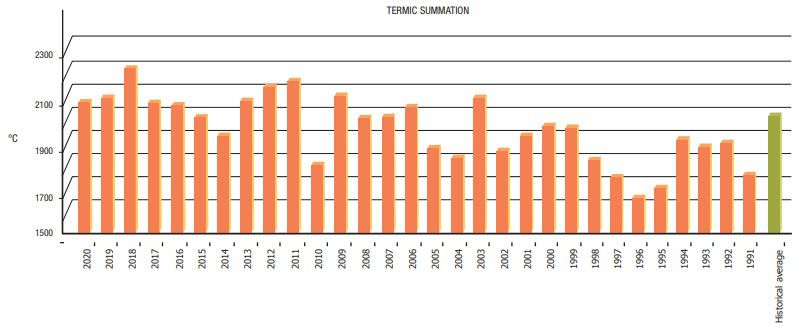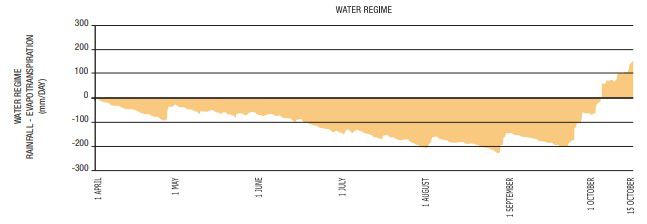VINTAGES
VINTAGE 2020
2020 GROWING YEAR
An overall good balance of weather conditions, with no extremes, was the main hallmark of this growing year. That allowed us to bring in a good crop of grapes that were textbook-ripe.
WEATHER CONDITIONS
As has happened often in recent years, low winter temperatures were followed by a sudden rise in temperatures in early March, which brought a budbreak that was 5 days early this year.
That occurred in early April, which then ushered in above-average temperatures and a lengthy dry spell. Reduced groundwater reserves so early in the season negatively impacted budbreak and shoot growth.
After this phase, the end of May experienced improved water availability and the situation returned to normal, with flowering taking place in accord with the norm, followed by satisfactory fruit set and successive development. The flowering began a full 10 days early with respect to 2019, and favourable weather conditions enabled the process to conclude in about one week (29 May through 6 June). Rainfall was frequent through the entire month of June, along with a substantial drop in temperatures; these conditions encouraged vine growth and berry development. Overall, the middle part of summer was quite balanced, with well-distributed rainfall, no temperature extremes, and daily maximums in the 30-35°C. range, with almost no highs over 35°C. These tempered conditions slowed down the physical growth parameters of the vines, bringing them to within historical averages. From late July through the end of the harvest, d groundwater supply diminished, but this did not create undue stress in the vines. Veraison for the early-ripening varieties began in late July with Pinot Grigio and in early August for the late-ripeners. Harvest started in the first few days of September, while just a few remaining lots of Pinot Grigio were picked in late August.
VITICULTURAL AND WINEMAKING CONSIDERATIONS
The dry period early in the season meant lower bud fertility, which in turn translated into fewer clusters per shoot, and thus per vine. An excellent flowering, along with satisfactory rainfall and temperatures in June encouraged berry multiplication and cellular development on the rather limited number of clusters, and to their increased weight (+8%). The progression of the season was marked by less heat than in previous years, but, important to underscore, without the water and heat stress that recent seasons have experienced as a result of climate change. With regard to fruit quality, precisely as a result of the deliberate pace of the seasonal conditions, the grapes displayed superb balance among the various accumulated components, including between organic acids and sugars. Aromatic ripeness heightened the expressiveness of the grape varieties, a quality even more evident in the various source crus of the grapes. Finally, it must be emphasised that, as always, only evolution over time of this vintage’s wines will enable us to truly evaluate the nobility of this vintage.






